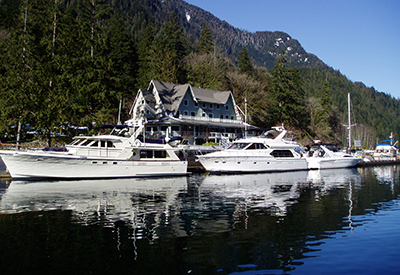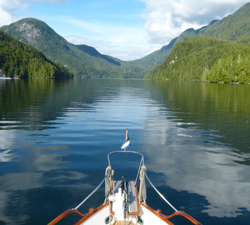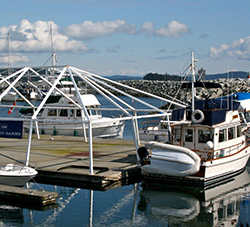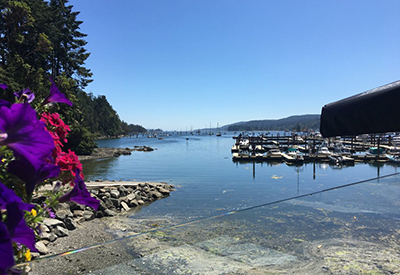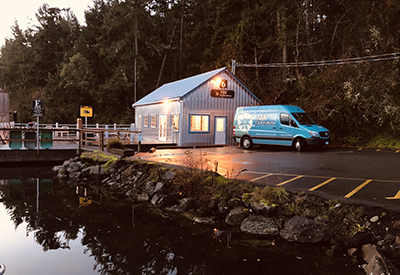The Royal Vancouver Yacht Club
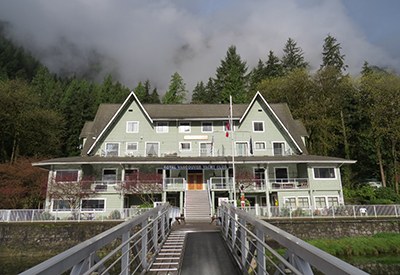
Katherine Stone
In 1791, a 36 foot sailboat from Spain, captained by Don Jose Maria Narvaez anchored off Point Grey and ventured into Burrard Inlet. The sailors noted several native settlements that were eager to trade and came close by in their dugout canoes. One year later, Captain George Vancouver arrived and set about surveying the coastline. After this flurry of activity the area remained undisturbed and it would be 70 years before the beautiful timber would be cut, sawmills built, and larger ships arriving in a steady stream.
This, my friends, was the beginning of Gastown and its many drinking establishments. As the main transportation was by water, young men with time on their hands, when they weren’t boozing, built their own sloops. The largest trees in the world grew in English Harbour which served well as tall straight spars. Well, one dare led to another and before you knew it organized racing was born. Soon the mill owners organized yacht and rowing races off the mill docks. Competitors came from all over and, “…the open sailboats were tied to a line stretched between the wharves until the signal was given to start”. These gentlemen got it right! There were no OCS (on course side) penalties given in those days. It is easy to see with the temperate climate that going fast in boats became a popular pastime.
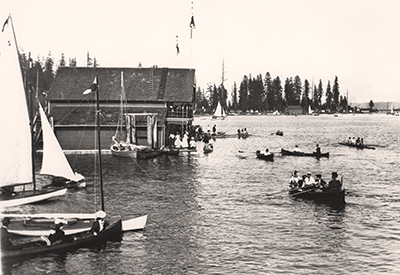 Gastown became Vancouver and was incorporated in April 1886. A spectacular blaze two months later destroyed most of the city and swampy shores of Burrard Inlet. Turning lemons into lemonade, the city was rebuilt with modern electricity, water and streetcar systems. The harbour was alive with sailing craft, one faster than the other. Not surprisingly, this soon led to wagers placed and fortunes passed from one hand to another. If your boat was over 30 feet you could pocket $100 in a Dominion Day race! Many yachting clubs were formed and many folded. Nothing seemed to “stick”. It took a campaign by the Yanks at the Seattle Times and the offering of a large trophy by an English firm to get the Vancouverites motivated and on track to establish a lasting yacht club in Vancouver in 1903. With a modest fleet of 18 boats and a rented house from the Vancouver Rowing Club, the Vancouver Yacht Club took root and by the end of the season had 100 active members.
Gastown became Vancouver and was incorporated in April 1886. A spectacular blaze two months later destroyed most of the city and swampy shores of Burrard Inlet. Turning lemons into lemonade, the city was rebuilt with modern electricity, water and streetcar systems. The harbour was alive with sailing craft, one faster than the other. Not surprisingly, this soon led to wagers placed and fortunes passed from one hand to another. If your boat was over 30 feet you could pocket $100 in a Dominion Day race! Many yachting clubs were formed and many folded. Nothing seemed to “stick”. It took a campaign by the Yanks at the Seattle Times and the offering of a large trophy by an English firm to get the Vancouverites motivated and on track to establish a lasting yacht club in Vancouver in 1903. With a modest fleet of 18 boats and a rented house from the Vancouver Rowing Club, the Vancouver Yacht Club took root and by the end of the season had 100 active members.
The “Annals of the Royal Vancouver Yacht Club” located on the club’s website outlines a colourful recounting of their first race, held that August. “As the leading yachts approached the place where the first buoy ought to have been, they were surprised to find it was not in sight. The yachts flitted around until the Commodore spied it – turned turtle. Those that could manage it, rounded the buoy and headed across the bay to the south shore where the buoy was sighted well up on the shore, near the English Bay Cannery. The survivors of the race headed for the finish line anyhow.” You can sure bet that there were more than a few stories over a few pints relaying the paths various boats took on that race.
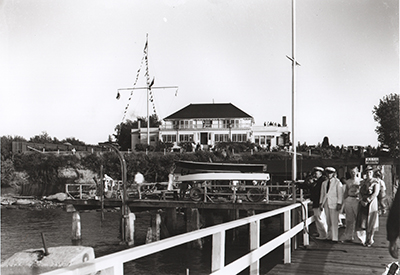 The club grew and the members realized that they needed a “proper” and permanent clubhouse with anchorage at Coal Harbour so a two story, 30×60 foot, floating building was completed. Built to last, the structure was still used until 1977 at the Coal Harbour Station as a spar house. Hardly had it been built when it was bursting at the seams with a membership that had swelled to 187. So a leased water lot was arranged and it was floated to the shelter of Deadman’s Island off of Stanley Park. At the same time, application was made for a royal charter. The arrival of the Royal Warrant was announced in 1906 and a new club burgee was designed to include the royal crown. At the time, some very smart yachtsmen took advantage of the extravagant $50 Life Membership. Finally, in 1927, after further expansion, a permanent Jericho clubhouse was officially opened.
The club grew and the members realized that they needed a “proper” and permanent clubhouse with anchorage at Coal Harbour so a two story, 30×60 foot, floating building was completed. Built to last, the structure was still used until 1977 at the Coal Harbour Station as a spar house. Hardly had it been built when it was bursting at the seams with a membership that had swelled to 187. So a leased water lot was arranged and it was floated to the shelter of Deadman’s Island off of Stanley Park. At the same time, application was made for a royal charter. The arrival of the Royal Warrant was announced in 1906 and a new club burgee was designed to include the royal crown. At the time, some very smart yachtsmen took advantage of the extravagant $50 Life Membership. Finally, in 1927, after further expansion, a permanent Jericho clubhouse was officially opened.
By 1978 the membership had grown to close to 1,400 and another expansion and renovation was done on the crowded clubhouse. One good thing led to another and the membership grew again to 1,600, which precipitated another complete renovation to accommodate the growing numbers in 1996. The extensive club library is a highlight that many a member has visited to update their reading library while cruising from biographies to boat design to shipwrecks to narratives to painting, there are over 40 different genres of books.
 In the tight Vancouver waterfront, dockage is at a premium and many members take advantage of the many outstations for extended, unparalleled cruising. After much opposition from the members (because of the distance to travel there) 28 acre Tugboat Island in Silva Bay on Gabriola Island was acquired in 1960. Cortes Bay on Cortes Island in 1993, is the most recent acquisition. Two of these outstations include full service marinas at Scott Point on Saltspring Island and Garden Bay in Pender Harbour. Club historian, David Williams, is very enthusiastic when he points out the advantages of RVYC. “We can sail year round. As well, with our seven offshore stations and two main marinas, the Club is a major centre for power boating on the coast; an ideal springboard for members to explore the rugged beauty and the isolation of the islands and fjords that remain unchanged from the vistas that attracted recreational boaters a century ago.”
In the tight Vancouver waterfront, dockage is at a premium and many members take advantage of the many outstations for extended, unparalleled cruising. After much opposition from the members (because of the distance to travel there) 28 acre Tugboat Island in Silva Bay on Gabriola Island was acquired in 1960. Cortes Bay on Cortes Island in 1993, is the most recent acquisition. Two of these outstations include full service marinas at Scott Point on Saltspring Island and Garden Bay in Pender Harbour. Club historian, David Williams, is very enthusiastic when he points out the advantages of RVYC. “We can sail year round. As well, with our seven offshore stations and two main marinas, the Club is a major centre for power boating on the coast; an ideal springboard for members to explore the rugged beauty and the isolation of the islands and fjords that remain unchanged from the vistas that attracted recreational boaters a century ago.”
The club has an active junior training program offering the Sail Canada Wet Feet, Optimist and Can Sail programs for members and non-members starting at age five. The RVYC Match Racing program was conceived in 2012 to promote match racing and enhance the racing skills of juniors moving out of the sailing program and adults wanting to learn more. With the acquisition of two Elliot 6m boats (with four more added recently) to add to the fleet of two Martin 242s, Monday night match-ups have become a going concern. There is also fleet racing Tuesday through Friday nights. Past Commodore James Burns feels that 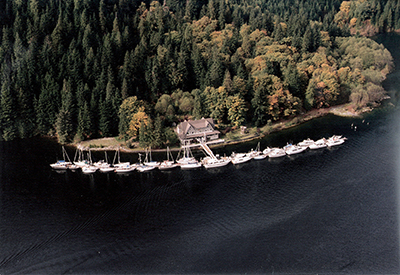 RVYC can pretty much hold its head up with all of the worlds’ great yacht clubs. As one of the premier yacht clubs on the west coast they actively contribute members to the Canadian sailing team and are very involved in the ICOYC (International Council of Yacht Clubs) and the Vancouver community.
RVYC can pretty much hold its head up with all of the worlds’ great yacht clubs. As one of the premier yacht clubs on the west coast they actively contribute members to the Canadian sailing team and are very involved in the ICOYC (International Council of Yacht Clubs) and the Vancouver community.
As a founding member of the ICOYC, RVYC can hold its own when hosting and running regattas, most recently the 2014 laser Canadians, 2014 Farr 30 North Americans and 2012 J/24 Canadian Championships. Every other even year, they partner with the Lahaina Yacht Club to host the Vic-Maui International Yacht Race, which covers over 2,308 nautical miles from Victoria, British Columbia to Lahaina, Maui. Many a talented sailor has come through the sailing programs and represented Canada in numerous provincial, national, and international regattas as well as the Olympics/Paralympics.
Their involvement in the community is stalwart with several special events for children. The Easter Seals Charity Regatta is run every year in partnership with the BC Lions Society for children with disabilities. Boat for Hope raises funds through skipper, corporate and community partners and allows a one-of-a-kind experience for the children and their families involved in Variety Club. A special children’s cruise aboard the MV Britannia, lets children experience the thrill of getting out on the water and also enjoying the volunteer efforts of the Vancouver Fire & Rescue, Armed Forces and RCA Band.
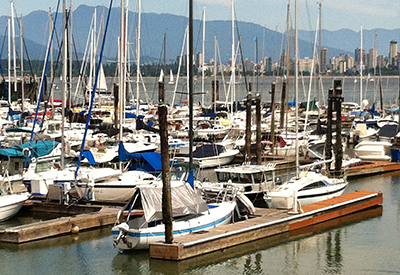 At present there are 2,200 Active and Associate Members, and the fleet numbers over 1,500 sailing and power yachts berthed at Jericho and Coal Harbour Stations or moored elsewhere. RVYC’s simple mission to promote yachting, seamanship and fellowship among members certainly holds true. A member since 1990, Lorne Chapman, talked to a lot of people when he moved out to Vancouver about the various yacht clubs with decent racing programs. RVYC was clearly above all, so the choice was easy from the start. Being single at the time, new in town, having the nice clubhouse looked like a good thing to have at his disposal to start building a social life.
At present there are 2,200 Active and Associate Members, and the fleet numbers over 1,500 sailing and power yachts berthed at Jericho and Coal Harbour Stations or moored elsewhere. RVYC’s simple mission to promote yachting, seamanship and fellowship among members certainly holds true. A member since 1990, Lorne Chapman, talked to a lot of people when he moved out to Vancouver about the various yacht clubs with decent racing programs. RVYC was clearly above all, so the choice was easy from the start. Being single at the time, new in town, having the nice clubhouse looked like a good thing to have at his disposal to start building a social life.
As David Williams says, “With the marvelous views of English Bay three floors, great food, racing and cruising programs, special events, and the jewel in the crown, our seven out stations, what’s not to like?”. See what you think – stop by and try them out.
Royal Vancouver Yacht Club; 3811 Point Grey Road; Vancouver, BC V6R 1B3; 604-224-1344;
 www.royalvan.com or reception@royalvan.com
www.royalvan.com or reception@royalvan.com
Photo Captions
Photo 1 – Easter Cruise weekend at Wigwam Inn 2014.
Photo 2 – First Clubhouse.
Photo 3 – Clubhouse 1938.
Photo 4 – First Flying Juniors set the stage for Sailing school in the early days.
Photo 5 – Wigwam Outstation respite.
Photo 6 – High tide in the Harbour.
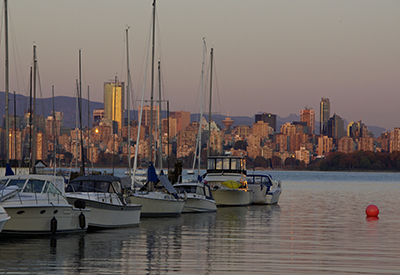 Photo 7 – Clubhouse 1959.
Photo 7 – Clubhouse 1959.
Photo 8 – Evening light – Jericho Port. Photo Credit Linda Mueller
Photo 9 – Iceberg Cruise to Wigwam Inn 2013.
